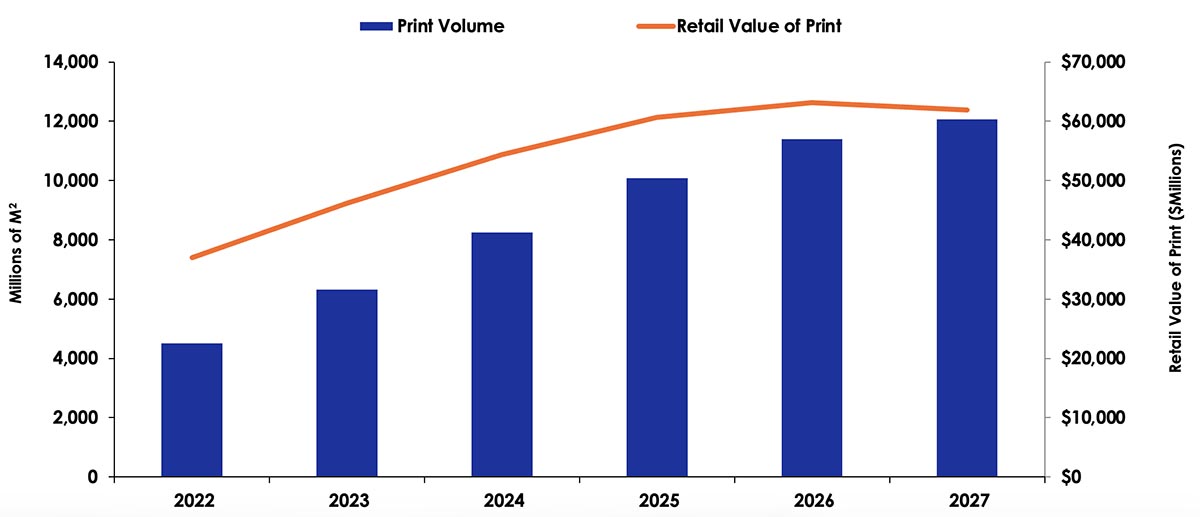- A little over a decade has passed since single-pass inkjet devices first entered the textile scene.
- Because the textile printing market continues to see rapid growth and rising consumer demand for larger volumes of customized clothing, the industry is beginning to rethink its supply chain and manufacturing methods.
- Keypoint Intelligence’s Worldwide Digital Textile Forecast projects that annual volumes of digitally printed textiles will exceed 12 billion square meters by 2027. Given this, the day for single-pass may have yet to arrive.
By Johnny Shell
Introduction
The first single-pass digital inkjet printer that was specifically designed to print textile fabrics came to market back in 2012. The MS Lario, launched by MS Printing Solutions SRL (now owned by Dover Corporation), set the stage for a new era of textile printing technologies. Running at previously unparalleled speeds for high-volume textile production, the Lario forever changed the paradigm of digital textile printing. It challenged the dominance of rotary screen printing by reaching production speeds that were never before achieved by any digital inkjet textile printer. This groundbreaking development was later followed by single-pass printers from other major digital printer manufacturers like Konica Minolta (Nassenger SP-1), SPGPrints (PIKE), and EFI Reggiani (Bolt).
What’s Next?
A little over a decade has passed since single-pass inkjet devices first entered the textile scene. Keypoint Intelligence recently conducted some research to develop a better understanding of where the technology stands today, what the next iteration of single-pass printers will look like, and what the future might hold for this technology. Our upcoming market insight report will explore present-day industry challenges and trends that are rapidly changing the market landscape. In addition to examining issues such as waste and pollution generated by traditional manufacturing processes and supply chain instability, it will provide an overview of traditional analog printing techniques and new digital printing technologies. The report will also include an in-depth review of leading single-pass textile printer models and analyze the disconnect between the high volumes of printed textiles and the reluctance by printers to adopt single-pass devices. Finally, it will cover end-users’ perspectives on the reluctant adoption of this technology and what might be needed to move single-pass printers to the next stage.
Because the textile printing market continues to see rapid growth and rising consumer demand for larger volumes of customized clothing, the industry is beginning to rethink its supply chain and manufacturing methods. Thanks to the boom in online retail sales, individual consumers now have the power to customize their own apparel and textile fabrics. Keypoint Intelligence’s Worldwide Digital Textile Forecast projects that annual volumes of digitally printed textiles will exceed 12 billion square meters by 2027. The retail value of print is expected to surpass $60 billion by the end of the forecast period, so it’s clear that volumes are coming. Unfortunately, single-pass textile printing has not yet gained the penetration that was first expected.
Figure 1. Digital Textile Print Volumes & Retail Value of Print

Source: Worldwide Digital Textile Forecast; Keypoint Intelligence 2023
Why Has Adoption Been Slow?
Even though today’s vendors offer many attractive single-pass textile printer options, adoption has been slow. Some of the leading OEMs in the single-pass space shared their opinions with us about why this might be the case:
- The learning curve: Operating and optimizing a single-pass inkjet printer can require a learning curve for operators due to its advanced technology and settings.
- Color gamut:Even though many single-pass devices provide excellent color reproduction, some multi-pass inkjet systems may offer a broader color gamut due to multiple passes.
- Maintenance: As is the case with any digital inkjet printer, single-pass textile printers will demand proper maintenance and periodic printhead cleaning for optimal performance.
- Operating conditions:It’s imperative that the operating environment be kept within the manufacturer’s recommended temperature and relative humidity ranges.
- Operator monitoring and interaction:For printed textiles to be produced at maximum speed and volume, constant monitoring of print results and machine performance is required. When problems do arise, the printer should be stopped to avoid excessive fabric yardage waste.
The Bottom Line
The day for single-pass textile printing may have yet to arrive. Fortunately, printer simplicity is improving, automated monitoring and self-correction technologies are advancing, inks are progressing, and printer footprints are becoming ever smaller. The merger of these factors with the increasing demand for sustainable, on-demand textiles and clothing might synchronize perfectly with single-pass technologies. We are already seeing new single-pass printers being announced that appear to improve complexity and automation while maintaining speeds. Only time will tell where single-pass devices will fall in the spectrum of digital textile printers, but all devices continue to improve in terms of print speed as well as price.
Subscribers to Keypoint Intelligence’s Functional & Industrial Printing consulting service can log in to our InfoCenter to view research on digital textiles, sustainability, and single-pass printing technologies. We also offer an array of market forecasts, show reviews, and industry updates. If you’re not already a subscriber, click here for more information.
Johnny Shell is the Director of Keypoint Intelligence's Functional & Industrial Printing Service. His solid commitment to organizational advancement and strategy-driven growth enable him to design and execute revenue-based strategies. Johnny is an Inductee of the Academy of Screen and Digital Printing Technologies, an international body of experts which honors qualified individuals through election to membership for their distinguished, long-term contributions to, and application and promotion of, screen and digital printing and associated imaging technologies for graphic, textile, industrial and electronic printing applications.














